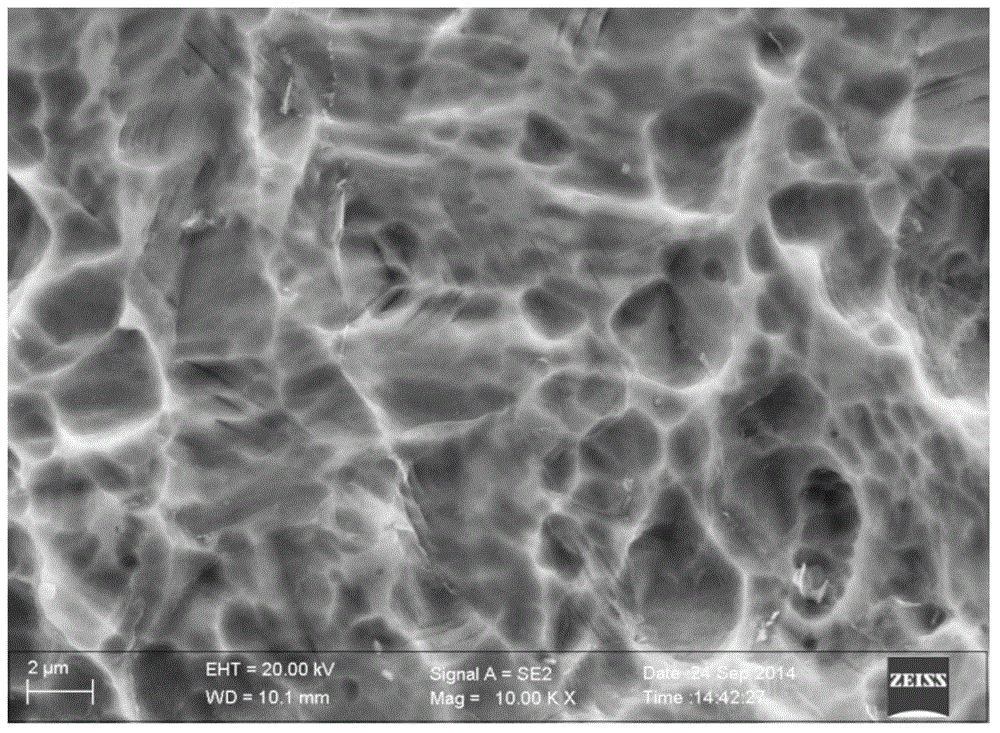Surface-nanocrystallization low-temperature aluminizing treatment method for steel products
A technology of aluminizing treatment and nanotechnology, which is applied in the field of surface engineering, can solve the problems of non-dense aluminized layer, high aluminized temperature, and long holding time, and achieve the effect of good combination, uniform distribution of elements, and improved surface properties
- Summary
- Abstract
- Description
- Claims
- Application Information
AI Technical Summary
Problems solved by technology
Method used
Image
Examples
Embodiment 1
[0034] In this embodiment, 316L stainless steel is taken as an example, and the low-temperature aluminizing after the surface nano-treatment referred to in the present invention is carried out, and the steps are as follows:
[0035] 1. Ultrasonic cleaning: Add alcohol with a mass fraction of 75% in the ultrasonic cleaning pool, and the volume of alcohol added accounts for one-third of the volume of the entire cleaning pool; put the steel parts into the ultrasonic pool for cleaning for 30-60 minutes; use clean water after ultrasonic cleaning Rinse until the surface is shiny and forms a continuous water film;
[0036] 2. Drying and degreasing: Put the rinsed steel parts in a drying oven, set the temperature at 200°C-350°C and bake until the surface is dry and oil-free; then put the baked steel parts into a mass fraction of 20 % to 30% hydrochloric acid solution, soak for 5 to 10 minutes; rinse the steel parts soaked in hydrochloric acid with running water for 2 to 8 minutes, and...
Embodiment 2
[0044] Taking the 40Cr steel piece as an example, the low-temperature aluminizing of surface nano-heating referred to in the present invention is carried out. Aluminized component mass ratio: 20% Al powder (200 mesh), 5% aluminum iron powder (200 mesh), 4% lanthanum chloride, 1% ammonium chloride, and the remaining 70% is filler alumina powder (100 mesh ).
[0045] According to the method described in Example 1, carry out surface nano-heating and low-temperature aluminizing: wherein the steel part is subjected to mechanical grinding surface nano-processing for 6h, Figure 4 In order to treat the microstructure and morphology of the surface after 6 hours, steel parts, two 40Cr metallographic test samples and aluminizing agent are packed together, sealed with water glass mud, and after consolidation, aluminized at low temperature (700 ° C) in a box furnace. Keep warm for 6 hours, cool with the furnace, take out the steel parts and metallographic testing samples from the box and...
Embodiment 3
[0047] Embodiment 3: Take 40Cr steel as an example:
[0048] Aluminized components: 20% Al powder (200 mesh), 5% aluminum iron powder (200 mesh), 4% lanthanum chloride, 1% ammonium chloride, and the remaining 70% is filler alumina powder (100 mesh).
[0049] Use the method described in Example 1 to carry out surface nano-heating and low-temperature aluminizing, and analyze the oxidation resistance of steel parts after aluminizing. Samples (dimensions of Quantity: 20 pieces) after mechanical grinding and surface nano treatment for 6 hours, pack it together with aluminizing agent, seal it with water glass mud, and after solidification, aluminize at low temperature (650°C) in a box furnace, keep it warm for 4 hours, and cool with the furnace. Remove the sample from the box and clean the surface.
[0050] Put the aluminized sample and the untreated sample into alumina ceramic crucibles respectively, put them together in a drying oven, heat the drying oven, and set the temperatu...
PUM
| Property | Measurement | Unit |
|---|---|---|
| Thickness | aaaaa | aaaaa |
| Corrosion current density | aaaaa | aaaaa |
| Surface hardness | aaaaa | aaaaa |
Abstract
Description
Claims
Application Information
 Login to View More
Login to View More - R&D
- Intellectual Property
- Life Sciences
- Materials
- Tech Scout
- Unparalleled Data Quality
- Higher Quality Content
- 60% Fewer Hallucinations
Browse by: Latest US Patents, China's latest patents, Technical Efficacy Thesaurus, Application Domain, Technology Topic, Popular Technical Reports.
© 2025 PatSnap. All rights reserved.Legal|Privacy policy|Modern Slavery Act Transparency Statement|Sitemap|About US| Contact US: help@patsnap.com



